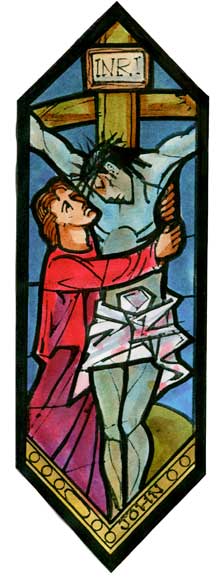|
|
|||

|
|||
John Window The final events of Jesus’ life unfolded rapidly. Soon after dinner, he was betrayed, arrested, and taken to the high priest for interrogation. There he was found guilty of blasphemy for claiming to be the Son of God, and then sent to the Roman governor Pilate to be executed—and to become the supreme expression of God’s love for the world. John, the beloved apostle, was the only one of the Twelve to watch this love revealed in Jesus’ final hours. The others fled at his arrest. John was initially a disciple of John the Baptist, but followed Jesus when the Baptist introduced him as the Lamb of God, a title pointing forward to Jesus’ sacrificial role in the events which John would witness. The same crowds who had welcomed Jesus at the beginning of the week now cried out for his death. Pilate gave Jesus to the soldiers to be scourged, mocked, and beaten; then they led him away to be crucified. On the cross Pilate hung a sign that read, “Jesus of Nazareth, the King of the Jews” (the accusation of treason against Rome for which Pilate agreed to his execution). As Jesus hung on the cross he prayed, “Father, forgive them.” Then, after putting his mother Mary into John’s care, he breathed, “It is finished!” bowed his head, and died. Suddenly, the earth shook, the temple veil was torn in two from top to bottom, and the dead were raised. Christ’s death was an event of cosmic significance, the turning point of all history. The New Testament calls it our ransom, redemption, salvation, and more—all ways to describe the final act of obedience that brought forgiveness of sin and restored humanity’s lost relationship with God. John witnessed Love’s ultimate sacrifice firsthand, and spent the rest of his long life passionately sharing it with others. His New Testament writings are filled with reminders of Jesus’ love, and exhortations to follow Christ’s example. Even when he was old and feeble, John would have himself carried into church to admonish his flock: “Little children, love one another.” John is shown removing Jesus’ dead body from the cross—Christianity’s preeminent symbol. Through it Christ destroyed death itself, and made possible the promise of eternal life.
Like Stars Appearing: The Story of the Stained Glass
Windows of St. George's Episcopal Church, Dayton, Ohio | |||
|
|||
